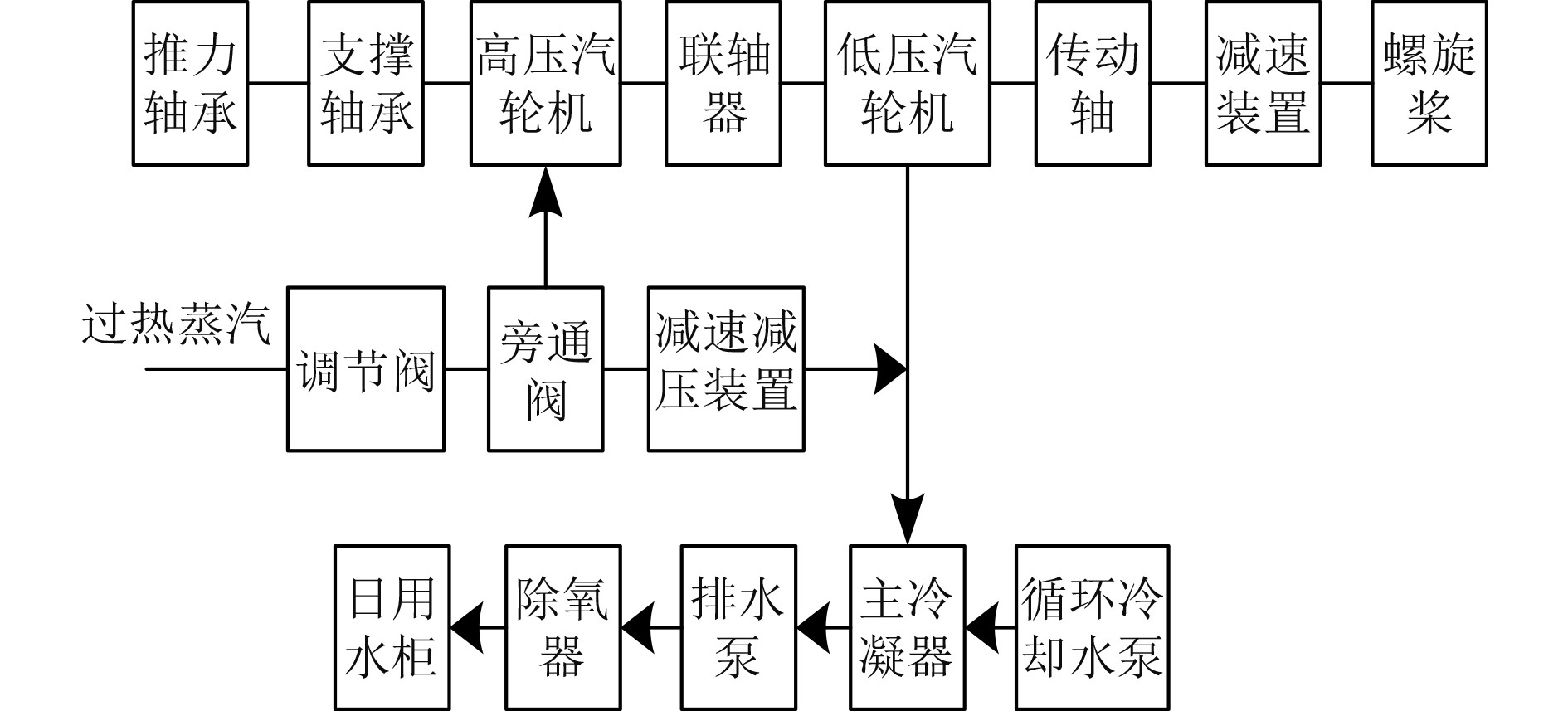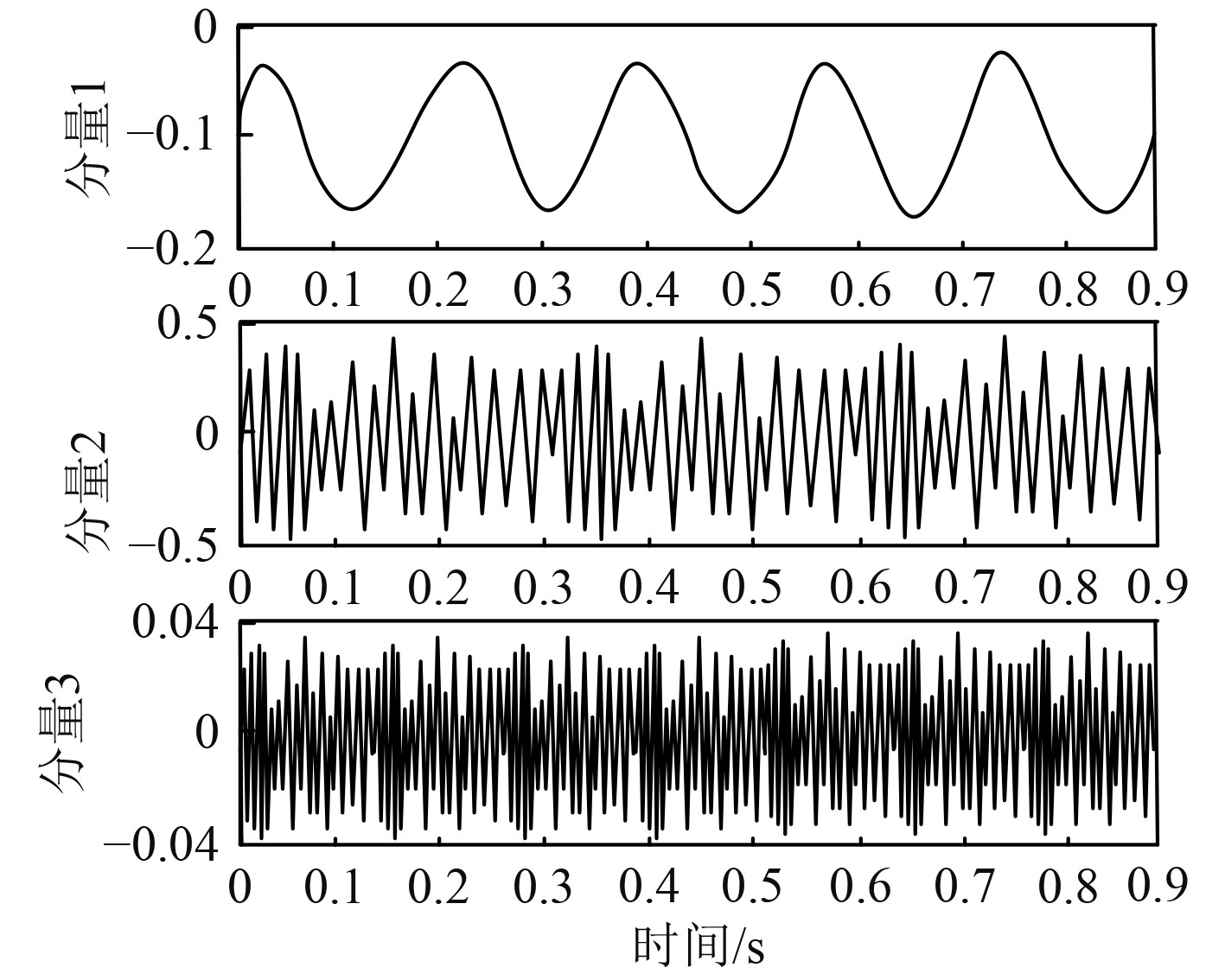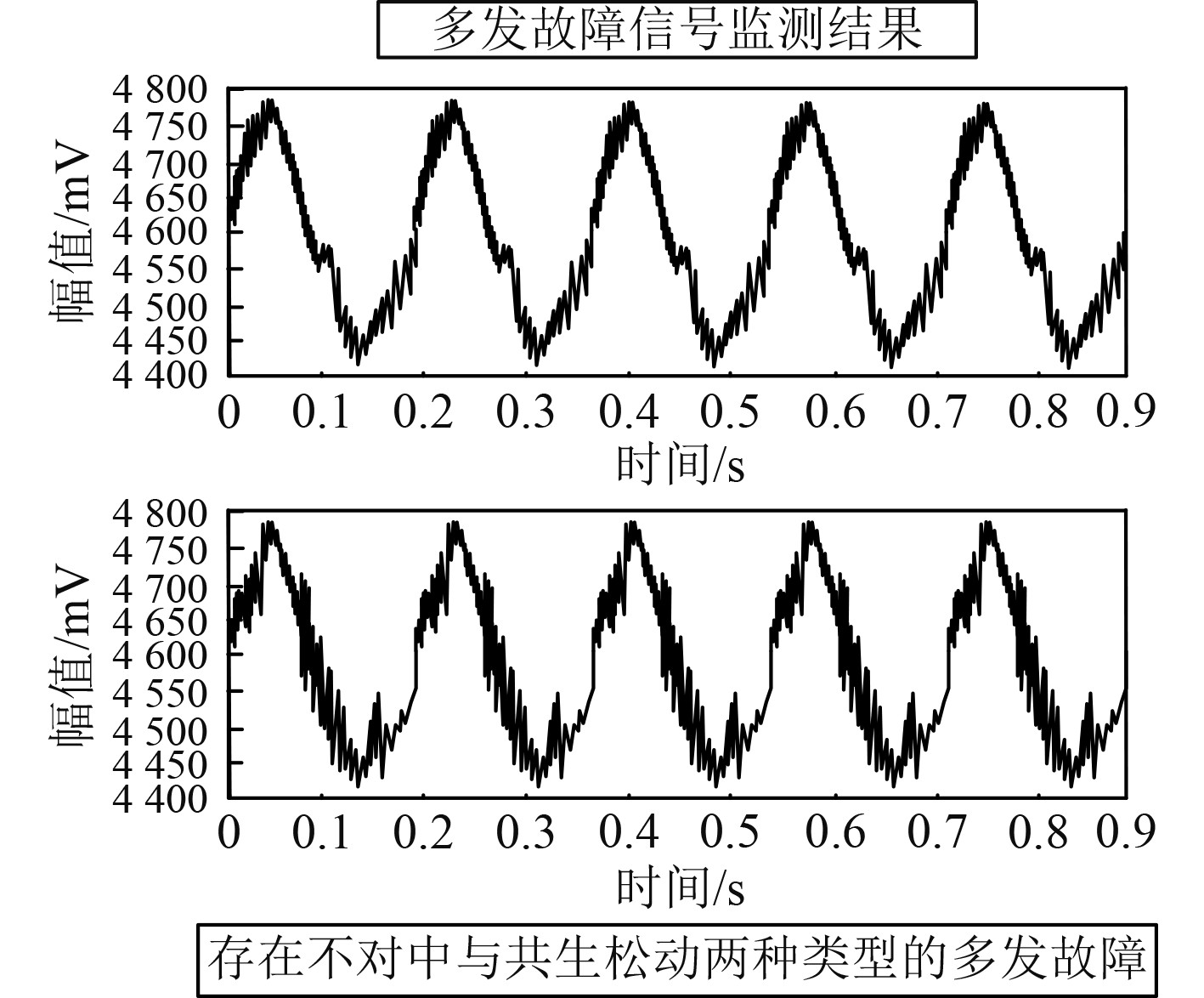船舶系统中轮机设备至关重要,直接影响船舶航行安全[1]。及时检修船舶轮机设备,可避免重大安全事故发生,而影响船舶检修效率与精度的因素是多发故障信号监测结果。多发故障代表同一设备出现同一故障的次数较多,及时发现多发故障,可有效防止严重故障问题[2-3]。为此,需研究故障信号监测方法。李汶骏等[4]利用混合核的核主元分析方法,完成轮机故障监测,该方法可有效在线监测轮机故障,具备较优的实用性。王崇宇等[5]利用深度卷积神经网络,实现轮机故障监测。该方法可有效监测轮机故障,监测精度高于95.47%,具备较优的鲁棒性。上述2种方法完成故障监测均依赖历史数据,具备一定的局部性与不确定性,易出现故障监测结果错误情况。多传感器融合是充分融合多个传感器资源,弥补单个传感器采集信息存在的冗余与缺失问题,解决信息采集的局部性与不确定性问题,为故障信号监测提供更为精准的数据支持。为此研究多传感器融合的船舶轮机设备多发故障信号监测方法,实现多发故障信号监测。
1 船舶轮机设备多发故障信号监测 1.1 船舶轮机设备多发故障信号特征提取利用多个传感器采集船舶轮机设备运行信号,令单个传感器采集的船舶轮机设备运行信号为x(t),其中,采样时间为t;分解x(t)获取
| $ x\left( t \right) = \sum\limits_{k = 0}^N {{x_k}\left( t \right)}。$ | (1) |
其中:k为信号本征模态函数编号。
将x(t)划分为N个不间断的区间,各小波滤波器间的边界是
| $ {\Lambda _n} = \left[ {{\omega _{n - 1}},{\omega _n}} \right],n = 1,2,\Lambda ,N ,$ | (2) |
确定
| $ x'\left( t \right) = \lambda W_x^e\left( {0,t} \right)*\mathop {{\phi _1}}\limits^\Lambda \left( t \right) + \sum\limits_{n = 1}^N {\lambda W_x^e\left( {n,t} \right)*\mathop {{\psi _n}}\limits^\Lambda \left( \omega \right)} 。$ | (3) |
其中:
| $ \begin{split} & W_x^e\left( {0,t} \right) = \int {\hat x\left( \omega \right){{\bar \psi }_1}\left( {\omega - t} \right){\rm{d}}\omega } ,\\ & W_x^e\left( {n,t} \right) = \int {\hat x\left( \omega \right){{\bar \psi }_n}\left( {\omega - t} \right){\rm{d}}\omega } 。\end{split} $ | (4) |
其中:
利用经验小波变换提取船舶轮机设备多发故障信号特征,具体步骤如下:
1) 利用尺度空间法划分x(t)的频谱,并分解x(t),获取xk(t),k=1,2,3,…,k+1;
2) 以方差为指标,再次分解首个x1(t),以x1(t)与邻近2个经验小波变换分量方差未超过0.01为,此时获取x(t)内的趋势信号x1(t);
3) 在x(t)内剔除x1(t),获取新的船舶轮机设备运行信号,并分解该信号。求解各xk(t)与x(t)相关系数rk,公式如下:
| $ {r_k} = \dfrac{{\displaystyle\sum\limits_{k = 1}^{N + 1} {\left( {{x_k}\left( t \right) - \bar x\left( t \right)} \right)\left( {{x_{kj}}\left( t \right) - {{\bar x}_k}\left( t \right)} \right)} }}{{\sqrt {\displaystyle\sum\limits_{k = 1}^{N + 1} {{{\left( {{x_k}\left( t \right) - \bar x\left( t \right)} \right)}^2}{{\left( {{x_{kj}}\left( t \right) - {{\bar x}_k}\left( t \right)} \right)}^2}} } }} 。$ | (5) |
其中:
在rk内选择最大值A,同时获取rk内全部超过0.85A的极大值数量,数量最多相应的原始本征模态函数,利用重构该本征模态函数,完成船舶轮机设备多发故障信号特征提取。
1.2 单个传感器的船舶轮机设备多发故障信号监测归一化处理单个传感器的船舶轮机设备多发故障信号特征
| $ RBF\left\{ \begin{gathered} {R^d} \to {R^m} ,\\ x' \to y 。\\ \end{gathered} \right. $ | (6) |
其中:
RBF的第k个隐藏神经元的高斯函数θk,θk的中心与宽度是
| $ {y_g} = \sum\limits_{k = 1}^q {\eta {w_{gk}}{\theta _k}\left( {x'} \right)}。$ | (7) |
其中:q为隐藏神经元数量;
通过式(7)可获取单个传感器的船舶轮机设备多发故障信号监测结果。
1.3 基于多传感器融合的多发故障信号检测以单个传感器的船舶轮机设备多发故障信号监测结果为基本概率分配函数,利用基于证据理论的多传感器融合方法,融合单个传感器的船舶轮机设备多发故障信号监测结果,获取最终的船舶轮机设备多发故障信号监测结果。多发故障信号监测原理为:以输出的单个传感器多发故障信号监测结果为基本概率分配函数,通过组合规则展开运算,按照融合结果完成多发故障信号监测。多传感器融合的船舶轮机设备多发故障信号监测框架是
| $ y:{2^\Theta } \to \left[ {0,1} \right];y\left( \varnothing \right) = 0;\sum\limits_{A \subset \Theta } {y\left( A \right) = 1}。$ | (8) |
其中:
| $ \begin{split} & B\left( A \right) = \sum\limits_{B \subseteq A} {y\left( A \right),\forall A \subset \Theta } ,\\ &P\left( A \right) = \sum\limits_{B \cap A \ne \emptyset } {y\left( B \right)} = 1 - B\left( A \right),\forall A \subset \Theta 。\end{split} $ | (9) |
式中:B(A)代表对于A的支持程度,P(A)代表不否定A的程度。
多传感器的船舶轮机设备多发故障信号监测结果的组合规则为:B1,B2为
| $ U = \sum\limits_{i',} {\sum\limits_{j'} {{y_1}\left( {{A_{i'}}} \right)} } {y_1}\left( {{C_{j'}}} \right) < 1,{A_{i'}} \cap {C_{j'}} = \varnothing 。$ | (10) |
其中:
因此,组合后新的基本概率分配函数
| $ y\left( S \right) = \left\{ \begin{gathered} \dfrac{{\displaystyle \sum\limits_{i',} {\displaystyle \sum\limits_{j'} {{y_1}\left( {{A_{i'}}} \right)} } {y_1}\left( {{C_{j'}}} \right)}}{{1 - U}},\forall S \subset \Theta ,S \ne \varnothing,\\ 0,\mathop {}\nolimits_{} \mathop {}\nolimits_{} \mathop {}\nolimits_{} \mathop {}\nolimits_{} \mathop {}\nolimits_{} \mathop {}\nolimits_{} \mathop {}\nolimits_{} \mathop {}\nolimits_{} S = \varnothing。\\ \end{gathered} \right. $ | (11) |
其中,S为组合后多传感器融合的船舶轮机设备多发故障信号监测证据的焦元。在
以融合后的y为船舶轮机设备多发故障信号监测的判断依据,以设置阈值的方式,完成多发故障类型信号监测。
2 实验结果与分析以某船舶轮机设备为实验对象,该轮机主要包含主调节阀与高、低压汽轮机等设备,结构如图1所示。利用本文方法监测轮机设备多发故障信号,在轮机的前后两端各安装1个振动传感器,用于采集船舶轮机设备运行信号,设置轮机设备共存在2种类型的多发故障,分别是不对中与共生松动。

|
图 1 船舶轮机结构图 Fig. 1 Structural diagram of ship turbine |
利用2个传感器采集该船舶轮机设备运行信号,以船舶轮机设备存在不对中故障时为例,2个传感器的采集结果如图2所示。根据图2可知,本文方法可有效采集船舶轮机设备运行信号,2个传感器采集的结果虽存在微小差距,但变化趋势大致相同。

|
图 2 船舶轮机设备运行信号采集结果 Fig. 2 Acquisition results of operational signals of marine turbine equipment |
利用本文方法在船舶轮机设备运行信号中,提取船舶轮机设备多发故障信号特征,以传感器2采集的信号为例,多发故障信号特征提取结果如图3所示。根据图3可知,本文方法可有效分解船舶轮机设备运行信号,清晰呈现设备运行信号的波形图,提取不同频率区间的多发故障信号特征,为后续多发故障信号监测提供数据支持。

|
图 3 多发故障信号特征提取结果 Fig. 3 Feature extraction results of multiple fault signals |
利用本文方法监测该船舶多发故障信号,监测结果如图4所示。根据图4可知,本文方法可有效监测船舶轮机设备多发故障信号,共监测到2种类型的多发故障信号,分别是不对中与共生松动多发故障,与实际多发故障类型相同,说明本文方法多发故障信号监测精度较高,可精准监测船舶轮机设备多发故障信号。

|
图 4 船舶轮机设备多发故障信号监测结果 Fig. 4 Monitoring results of multiple fault signals of marine turbine equipment |
船舶故障检修属于确保船舶安全航行的关键,船舶检修时,需要依据多发故障信号监测结果,实现快速、精准维修。为此研究多传感器融合的船舶轮机设备多发故障信号监测方法,精准监测多发故障信号,确保维修人员可尽早发现船舶轮机设备存在的各种故障问题,保证船舶航行安全。
| [1] |
田慧, 林叶锦, 张均东, 等. 基于单分类算法OSVM船用燃气轮机状态评估[J]. 船舶工程, 2020, 42(7): 152-156. TIAN Hui, LIN Yejin, ZHANG Jundong, et al. Condition evaluation of marine gas turbine based on single classification algorithm OSVM[J]. Ship Engineering, 2020, 42(7): 152-156. DOI:10.13788/j.cnki.cbgc.2020.07.25 |
| [2] |
赵骏, 朱嵘嘉, 陈鹏, 等. 基于模糊状态观测器的燃气轮机转速传感器故障检测研究[J]. 传感技术学报, 2019, 32(8): 1227-1231. ZHAO Jun, ZHU Rong-jia, CHEN Peng, et al. Study on speed sensor fault diagnosis for gas turbine based on fuzzy state observer[J]. Chinese Journal of Sensors and Actuators, 2019, 32(8): 1227-1231. DOI:10.3969/j.issn.1004-1699.2019.08.017 |
| [3] |
曾友渝, 谢强. 基于改进RNN和VAR的船舶设备故障预测方法[J]. 计算机科学, 2021, 48(6): 184-189. ZENG You-yu, XIE Qiang. Fault prediction method based on improved RNN and VAR for ship equipment[J]. Computer Science, 2021, 48(6): 184-189. DOI:10.11896/jsjkx.200700117 |
| [4] |
李汶骏, 龙伟, 曾力, 等. 基于差分进化和核主元分析的燃气轮机故障检测[J]. 四川大学学报(自然科学版), 2021, 58(2): 83-89. LI WenJun, LONG Wei, ZENG Li, et al. Fault detection of gas turbine air path system based on KPCA and DE[J]. Journal of Sichuan University (Natural Science Edition), 2021, 58(2): 83-89. DOI:10.19907/j.0490-6756.2021.022004 |
| [5] |
杨新, 于佐东, 张志远, 等. 基于多特征提取与核极限学习机的汽轮机转子故障诊断[J]. 汽轮机技术, 2020, 62(2): 137-142. YANG Xin, YU Zuodong, ZHANG Zhiyuan, et al. Fault diagnosis of steam turbine rotor based on multi feature extractions and kernel extreme learning machine[J]. Turbine Technology, 2020, 62(2): 137-142. DOI:10.3969/j.issn.1001-5884.2020.02.017 |
 2022, Vol. 44
2022, Vol. 44
